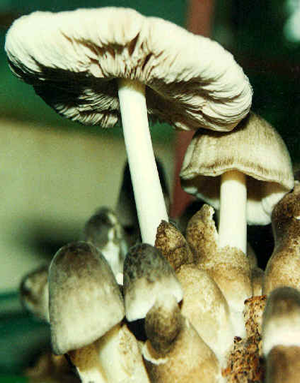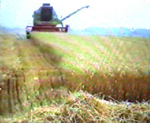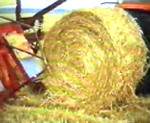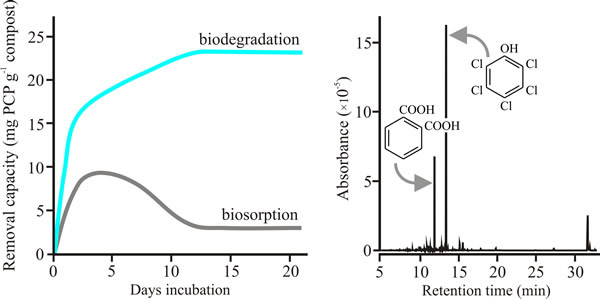1.5 21st century fungi
Fungal protein foods can compete successfully with animal protein foods like meat on health grounds:
- good content of protein (20-30% of dry matter) that contains essential amino acids;
- chitinous walls as a source of dietary fibre;
- contain B-vitamins;
- low in fat;
- virtually free of cholesterol.
Because fungal foods can be produced using waste products as substrates, they should also be able to compete successfully on grounds of primary cost.
Industry produces wastes...
 |
 |
| Oyster mushrooms (Pleurotus ostreatus) | Paddy straw mushrooms (Volvariella volvacea) |
| Photographed by Dr S.W. Chiu | |
Oyster and paddy straw mushrooms grow well on cotton waste of textile and garment industries.
Agriculture is also a major producer of wastes...
 |
 |
 |
| The cereal harvest produces waste cereal straw | One of many fields of rape (canola) | |
| All photographs © David Moore 2011 | ||
Typically, 80 to 90% of the total biomass of agricultural production is discarded as waste (better described as lignocellulose residues). And not just cereal crops. All agricultural production generates enormous waste because so little of each crop is actually used: 95% of the total biomass produced in palm and coconut oil plantations is discarded as waste, 98% of the sisal plant is waste, 99.8% of coffee biomass is waste, 83% of sugar cane biomass is waste. So, from the entire field of rape (canola) shown in the panel above only the oil from the seeds will be used.
Annual production of lignocellulose residues generated by different agricultural sources |
|
|---|---|
Lignocellulosic residues |
Millions of tonnes |
Sugar cane bagasse |
380 |
Maize straw |
191 |
Rice shell |
188 |
Wheat straw |
185 |
Soya straw |
65 |
Yuca straw |
48 |
Barley straw |
42 |
Cotton fibre |
20 |
Sorgum straw |
18 |
Banana waste |
15 |
Mani shell |
11.1 |
Sunflower straw |
9.0 |
Bean straw |
5.9 |
Rye straw |
5.2 |
Pine waste |
4.6 |
Coffee straw |
1.9 |
Almond straw |
0.49 |
Hazelnut husk |
0.24 |
Sisal and henequen (Agave) straw |
0.093 |
| Source: Modified from Sánchez (2009) and based on Food and Agriculture Organisation (FAO) and similar official sources. | |
Note that the Table above shows official estimates of the annual production of these agricultural wastes. The amounts are staggering; the total of the entries shown in Table 14 is 1.2 billion metric tons, and does not include municipal solid wastes like waste paper or garden refuse collected for recycling. This is an unacceptable loss of primary production but we could grow a lot of fungi on agricultural residues and convert wastes into food, animal feed, pharmaceuticals and other products.
Bioconversion of lignocellulose into useful, higher-value products normally requires multi-step processes, the steps including:
- collection and mechanical, chemical or biological pretreatment;
- hydrolysis of polymers to produce readily metabolised (usually sugar) molecules;
- fermentation of the sugars to produce a microbial or chemical end-product;
- separation, purification, packaging and marketing.
The major component of lignocellulose materials is cellulose, followed by hemicellulose and lignin, intermeshed and chemically bonded by non-covalent forces and by covalent cross-linkages. Because fungi, particularly white-rot fungi (Basidiomycota), have particularly efficient lignocellulose degradation enzyme machinery they might be attractive components of low-cost bioremediation projects (Chiu et al., 2000; Kumar et al., 2008; Sánchez, 2009).
Opportunities for the twenty-first century - themes for exploitation
- use of substrates that are waste products from other industries;
- combining bioremediation with mushroom crop production;
- leading to sustainable use of a wider range of the biodiversity evident in natural populations.
It’s an attractive notion to use the fungus to digest the waste and by so doing produce a cash crop of mushrooms. Even more attractive is that after the mushrooms have been harvested the ‘spent compost’ can be a useful:
- animal feed (the mushroom mycelium boosts its protein content);
- soil conditioner (it is a compost still rich in nutrients and with polymeric components that enhance soil structure);
- and spent mushroom compost can even be used to digest pollutants (like polychlorinated phenols) on land-fill waste sites because it contains populations of microorganisms able to digest the natural phenolic components of lignin.
Many wastes are hazardous because they contain tannins and phenolics, toxic to plants and animals:
- residues from extraction of oils such as cotton, rape, olive, palm oils;
- fruit processing residues, such as citrus wastes;
- wastes contaminated with pesticides.
Bioremediation with fungi
Several cultivated mushrooms (e.g. Pleurotus and Lentinula species) can degrade lignin in plant litter. And these enzymes detoxify phenolic residues as well. Producing a crop of mushrooms whilst disposing of an otherwise hazardous waste has become a popular ‘research model’ in recent years. Pleurotus cultivation may even aid removal of pollutants from landfill or contaminated waste sites. For example the following panel shows laboratory-scale bioremediation with Pleurotus; the spent compost is able to remove the biocide pentachlorophenol (PCP) very effectively.
 |
| Data showing that incubation for a few weeks with spent Oyster mushroom compost leads to destruction of pentachlorophenol (not just its adsorption)(left hand panel), and that mycelium of Pleurotus pulmonarius dechlorinates pentachlorophenol (PCP) through a catabolic process that involves removal of the chlorine followed by opening of the benzene ring (right-hand panel). For the left-hand plot, absolute removal capacity of PCP by spent oyster mushroom substrate (that is, the substrate left after the last crop was harvested) was quantified by capillary electrophoresis. The right-hand panel shows a mass-selective gas chromatography (GC-MS) spectrum of the extract of the fungal biomass of Pleurotus pulmonarius mycelium after 2 days incubation in a medium containing 25 mg l-1 pentachlorophenol. The most prominent peak (retention time 13.53 min) is PCP, the next most prominent peak at 12.03 min is benzene-1,2-dicarboxylic acid (also called phthalic acid). Other peaks at longer retention times include fatty acids that result from opening the benzene ring and esterification of its straight-chain derivatives. For example, peaks at retention times of 15.73, 31.96 and 32.25 min have been identified as hexadecanoic acid (palmitic acid, C16H32O2) and its derivatives. Modified and redrawn from Chiu et al., 1998. |
PCP has been the most heavily used pesticide throughout the world; it is very persistent in the natural environment and a common cause of soil contamination. Using spent mushroom substrates in landfill sites combines soil conditioning with degradation of organopollutants as an effective strategy for bioremediation in situ.
Heavy metal warning ...
But the idea is not free of problems. Oyster mushrooms can concentrate the metal cadmium (a common industrial contaminant) to such an extent that by eating less than 30 g (dry weight) of the most contaminated samples you would exceed the weekly limit tolerated by humans. Cadmium is so toxic that this situation could pose a public health hazard (cadmium poisoning causes kidney, liver and skeletal disorders). There are no worries about conventionally cultivated oyster mushrooms. The point is that if the mushroom is grown on composts that might be mixed with industrial wastes (in remediation programmes, for example), then it would be advisable to monitor the heavy metal contents before mushrooms are marketed for food. By far the most promising technique is use of the spent mushroom substrates remaining after harvesting mushroom crops. Ironically, these are often discarded as wastes themselves, but they are clearly able to offer an integrated approach combining soil conditioning with degradation of pollutants as an effective strategy for bioremediation in situ.
The non-green revolution
One thing we must do is make better use of what the Earth already produces. On average, agriculture currently loses 40% of its primary production to pests and diseases and then throws away more than 70% of what’s left because the crop always represents so little of what is grown. That works out to an overall 18% efficiency, at best. Fungi, especially the mushroom fungi, are ideal candidates to degrade waste vegetation, including any polluted with pesticides. Many pesticides are chemically similar to the complex phenolic compounds found in wood and because the fungi can decompose wood, they can also be used to degrade environmental pollutants in soils and wastewater discharges.
Wake up to fungi!
Arguably, the first higher organisms to evolve, in a sense fungi gave rise to plants and animals, maybe 2 billion years ago. Later, they enabled plants to invade the land to start terrestrial development of planet Earth, helping the plants to shape nature as we know it today. We would not be here without fungi because their interventions and contributions have been crucial in the development of life on land to the point where it could support larger animals. And all the while, the fungi themselves were so well adapted to even dramatically changing environments that their own evolution was slow and relaxed.
Read more about these and many other topics in the textbook 21st Century Guidebook to Fungi.
If you would rather have a book for the general reader about the world of fungi try this one:
 |
Slayers, Saviors, Servants and Sex: An Exposé of Kingdom Fungi by David Moore was published in both hardback and paperback editions in 2000 by the New York office of Springer-Verlag. ISBN-10: 0387951016, ISBN-13: 9780387951010.
Contents
- Toxins - kill the primates, rule the world. Or: Don’t turn your back on a fungus!
- Blights, rusts, bunts and mycoses.
- Decay and degradation, a fungal speciality.
- Joining forces - fungal co-operative ventures.
- Fungi in medicine - antibiotics and other pharmaceuticals.
- Turning the tables. Using fungi to control other pests.
- Let’s party!
- The old Kingdom in time and space.
- Birds do it. Bees do it. Even educated fleas do it. But why?
- The cavalry is coming. Fungi to the rescue.
- Word games. Solutions to word games.
We should know more about fungi. They have killed us, saved us and served us since before written records began. We have been making bread, brewing ale, and fermenting wine for millennia. Our crops have been at the mercy of fungal diseases since we became farmers, and they still are. Fungal diseases have caused large demographic changes - from the great plague of "St. Anthony’s Fire" of the Middle Ages (caused by a fungal toxin) to the Irish mass migration to the Americas during the famine (caused by a fungus-like disease of the potato crop).
We can also thank fungi for antibiotics, but do we fully appreciate the revolution in life style (and life expectancy) that these taken-for-granted treatments permit? One of the first people to receive penicillin treatment in England in the 1940s was a policeman in Oxford. He died of septicemia when the supplies of the antibiotic ran out. Cause of death? Scratched by a rose thorn!
Fungi enabled plants (by a mutualistic combination that persists today) to invade the land during the evolution of life on Earth. Higher fungi are almost unique in their ability to decay the chemical components of timber. Without the wood-rotting fungi we would be up to our eyes in dead trees! Fungi give us the opportunity of treating plant diseases and killing specific weeds, as well as being very useful for cleaning up polluted environments and for producing chemicals.
In short, this book will show you why it is wise to look again at fungi and appreciate these extraordinary organisms for what they are: a vital component of our lives and of the Earth’s ecosystem. View on Amazon.
